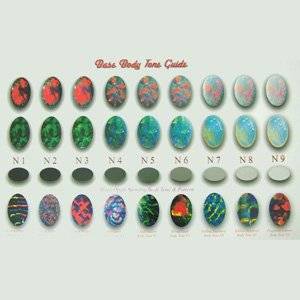How Does Our Opal Classification System Work?

Our classification system is based on the Australian Opal Ebusiness Association (AOEA) Opal Classification Standard, and looks to provide the most detailed information relating to each unique stone, so that you are able to make an informed choice. While there is obviously nothing better than viewing a stone in person, we take care to provide informative videos and photographs that make it easier for our customers to make the right decision.
Our Classifications Explained
ID - Every stone has a unique identification number that it is given during processing.
Category - A stone that is naturally cut and polished is typically categorized as a 'Solid' stone. This is different from man-made stones like doublets or triplets that integrate black backing layers, and another protective layer. Boulder opals are those stones which have a dark ironstone backing.
A stone is considered a black opal if it displays a dark body tone. Most black opals are mined from the Lightning Ridge region in New South Wales. The darker body tone makes the stone more vibrant and the black opal is generally considered the most sought after kind of opal.
Boulder opals are typically mined in Western Queensland and incorporate a brown ironstone layer on their backs. Boulder opals also have a dark body tone.
Crystal opals are those stones that have a transparent or translucent quality associated with them. The enhanced clarity that these stones offer is what makes them very valuable. Crystal opals typically have a light coloured body tone, however black crystal opals have also been found.
Semi-black opals have a light to medium grey body tone. These kinds of stones generally fall into the category of 'Dark Opals'. These stones are mined at Lightning Ridge in New South Wales, but are also found in White Cliffs and South Australia.
White opals are stones with a white or pale white body tone. These stones are abundant in South Australia and typically do not possess the same vibrancy as their black opal counterparts.
Setting - The setting refers to the carat of gold used, or whether White Gold or Yellow Gold is used.
Weight - The carat weight is an important factor in determining the value of an opal. Five carats are the equivalent of a gram. The more carats a stone has, the greater its value.
Origin - The origin relates to the location in Australia where the stone was mined.
Dimensions - The dimensions of an opal stone are measured in millimeters. For stones in freeform shape, the dimensions are measured using the widest points of the stone.
Thickness - Thickness is determined by measuring the width of the stone from the center. Thickness does not take into account just the precious opal, but the potch (colourless opal) as well.
Body Tone Index - We use a tone scale to identify the category to which a stone belongs. Darker stones offer increased vibrancy. Boulder opals are classified as having a body tone of zero since they contain a layer of ironstone that changes the overall body tone of the stone.
Transparency - This is also known as the 'diaphaneity' of a stone. Transparency relates to how well one can see through the stone.
Shape - There are five main types of shapes when talking about opals. These are freeshape, cabochon, low cabochon, medium cabochon and high cabochon. The way a stone is cut is dependent on the type of the stone.
Colours - An opal is valued by the range of colours in the spectrum that it displays. The colour 'Red; is the rarest and a stone displaying all colours including 'red' is said to be the most valuable.
Brightness - Brightness is divided into three categories - Subdued, Bright and Brilliant. Stones that are brilliant in appearance are generally considered more valuable than others.
Pattern - The pattern of a stone relates to the arrangement of colours on the surface of the stone. There are a wide range of patterns observed in opal stones. Some of them are Floral, Pinfire, Broad Flash, Rolling Flash, Ribbon, Flagstone, Straw, Chinese Writing and Harlequin.


